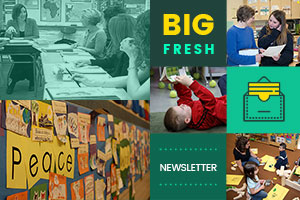A desk is a dangerous place from which to view the world.
John le Carre
I have to admit when I was a kid some of the most appealing reasons to become a teacher were the big festive earrings, clunky necklaces, and a teacher’s desk. Fast forward 20 years and none of these elements are present in my classroom (okay, I do love a colorful pair of clunky earrings but at least they are not holiday-themed).
What I didn’t realize back then when I was distracted by those shiny objects is that teachers who take the time to know their students are the best at their jobs. Several years ago when I was a new teacher I had difficulty finding time to get to know my students well. I often wondered how some teachers did it. I finally realized my beautifully decorated and organized desk was really a too-tempting time trap! I made the space so comfortable that I spent any non-instructional time responding to emails, checking student work, and browsing instructional resources on the web.
My desk was creating distance between students and me. It had to go! The next summer I asked the custodian to move my desk to the storage room, and I haven’t had one since. In its place is a small student desk with just enough room for my teacher computer, accompanied by a not-so-comfortable wooden stool. This space is now strictly business, no leisure: attendance and quick emails. What about storage? I cleaned out a locking file cabinet drawer and place my personal belongings there. What if my feet are killing me or I have paperwork to? If I need to sit down, I take the seat of an absent student and enjoy chit chatting with a new table group each day, getting to know my students more each day and letting them learn a bit more about me.
Now is the time many teachers start looking forward to winter break and consider New Year’s Resolutions. As you look at your classroom, picture it without a teacher’s desk. Think of other ways you or your students could use the space. If you give your desk the boot, you may be surprised at how liberating the results are.
This week we’re focusing on strategies for teaching literary themes. Plus more as always — enjoy!
Melissa Styger
Contributor, Choice Literacy
Melissa Styger is a third-grade teacher in Centralia, Washington.
Free for All
[For sneak peeks at our upcoming features, quotes and extra links, follow Choice Literacy on Twitter: @ChoiceLiteracy or Facebook: http://www.facebook.com/ChoiceLiteracy or Pinterest: http://pinterest.com/choiceliteracy/]
Here are two features from the Choice Literacy archives to help you tackle the concept of theme in your classroom.
Franki Sibberson has advice for using Picture Books to Teach Theme:
http://www.choiceliteracy.com/articles-detail-view.php?id=547
Aimee Buckner Teaching Themes Through Keywords from Aimee Buckner is a simple strategy to help students read texts closely to get at deeper meaning:
http://www.choiceliteracy.com/articles-detail-view.php?id=378
Kate Roberts and Maggie Beattie Roberts find Standard 5 of the Common Core (dealing in part with how structure relates to theme) looks easy to teach but it’s not. They have suggestions for ways to scaffold student learning at their indent blog:
With the rise of the Common Core, a flood of new programs from publishers has naturally followed. Vicki Vinton has wise advice about staying true to what we know about teaching and learning in What’s the Difference Between a Teacher and a Packaged Program?:
For Members Only
Karen Terlecky explains how she designs instruction and uses mentor texts to teach theme, and includes a video example of a minilesson:
http://www.choiceliteracy.com/articles-detail-view.php?id=1619
Franki Sibberson writes about how she chooses books for theme instruction and shares Two Lessons for Teaching Theme:
http://www.choiceliteracy.com/articles-detail-view.php?id=1875
We’ve posted a new cluster on Rethinking Strategy Instruction with contributions from Andie Cunningham, Shari Frost, Clare Landrigan, Sean Moore, Tammy Mulligan, and Ruth Shagoury:
http://www.choiceliteracy.com/articles-detail-view.php?id=1865
Kelly Petrin meditates on the importance of patience when looking for ways to connect with preschoolers in Dandelions, Chinese, and Patience with Our Youngest Learners:
http://www.choiceliteracy.com/articles-detail-view.php?id=1821
New PD2Go: Max Brand describes how he uses images to build reading and writing skills among his kindergartners:
This video and workshop guide fulfills Common Core State Standard
ELA-Literacy.RF.K.1: Demonstrate understanding of the organization and basic features of print.
That’s all for this week!



